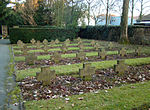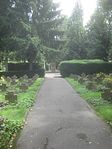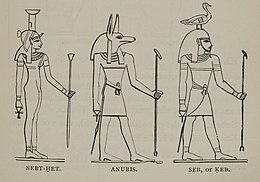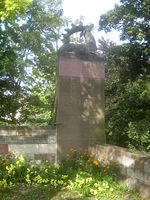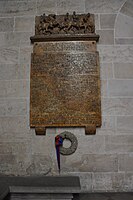War memorial 1914/18 (Ludwigsburg)
The war memorial 1914/18 was erected in 1924 by the city of Ludwigsburg to commemorate those who died in the war in the so-called cemetery of honor of the old cemetery .
The memorial is a stone circle , which is surrounded by a hedge that is taller than a man, behind which nine larger-than-life steles with sunk reliefs are hidden. The main relief shows the warlike figure of the Archangel Michael with the flaming sword. Six reliefs depicting fighters and two reliefs depicting mourning mothers with their children are lined up around it.
The stone circle was designed by the architect Friedrich Haußer, the reliefs by the sculptor Jakob Brüllmann . Both had already worked together in 1916 on the construction of the cemetery of honor.
location
In the south of the old cemetery, the so-called Ehrenfriedhof, an elongated, almost rectangular field of soldiers' graves (pink area in the cemetery plan), borders the west-east running Schorndorfer Straße. Four war memorials are arranged in the cemetery parallel to the street.
If you enter the cemetery via the entrance on Schorndorfer Straße, you come across the war memorial 1939/45 , a neo-Gothic cemetery chapel consecrated in 1868 , which was redesigned as a war memorial in 1957 . On the left the path leads to the memorial of the 260th Infantry Division , on the right you reach the war memorial 1914/18 after 40 meters . The war memorial 1870/71 finally follows on the northeast corner of the burial ground .
Cemetery of honor
During the First World War , the city of Ludwigsburg had a "cemetery of honor" laid out in the old cemetery between the chapel and the war memorial in 1870/71 for soldiers who died in the military hospital in Ludwigsburg (or who were transferred to Ludwigsburg). The cemetery of honor was laid out according to plans by Friedrich Haußer. According to the design by Jakob Brüllmann, the graves of the team ranks were given "low but worthy stone crosses, all of the same size, shape and color", while the officer's graves were covered on the sides with stone slabs.
Stone circle
The memorial was as Ehrenhain created to "slightly elevated plateau" within the cemetery honor, "there where a group of highly aspiring trees spreads a fantastically silent solemnity over the room," and inaugurated on 5 October 1924th The “holy round square” has the same diameter as the chapel at around 15 meters and is surrounded by a hedge that is taller than a man. The space behind the hedge consists of a wide walkway, a ring of nine massive, larger-than-life steles and a slightly recessed space in the middle, with irregularly cut stone slabs, to which two steps lead down. The upper step bears the inscription "God's Will 'hat / no why" on the front side to the left and right of the figure of the Archangel Michael. In 1988 there was still a tree in the square that had been left in the circle, but which has now disappeared. When looking at the circle of steles, one is involuntarily reminded of stone circles like those of Stonehenge , which were also used as graves.
Reliefs
"The inner side of the ring was given by the architect to express the tremendous events of the years 1914-18 in this sacred place in order to make it a deep inner experience for the viewer." That is a contemporary description of the memorial.
The nine larger-than-life, block-like, massive steles made of red Maulbronn sandstone have expressive reliefs with the Archangel Michael, depictions of fighters and mothers with their children on the front. The back bears inscriptions with the name, date and place of death of the fallen soldiers.
The framing of the tall rectangular stone slabs is roughly hewn and stands in sharp contrast to the finely and softly contoured figures of the reliefs and the smooth ground of the writing tablets.
archangel Michael
- Stele of the Archangel Michael
“During the First World War, the Archangel Michael was the leader and patron of the Germans. His rendering combined relics of various origins: the earlier identification with the emperor, the German heroes Goethe and Bismarck and even Germanizing motifs. The result of the mixture was a radiant youthful fighter, a Siegfried as the patron saint of the German army. "
In contrast to the figures on the other steles, the archangel Michael, a youthful but nonetheless martial, is depicted in archaic frontality . Equipped with steel armor and a helmet from under which the flowing hair oozes out, the winged archangel looks fearless and courageous into the world. He relies on his mighty flaming sword with which he drove the first people out of paradise.
The back of the Michael stele is divided into three fields:
- A large relief image below shows an ash urn and above it a skull, which is bedded on crossed mallets. Flames leap up around the skull.
- A small relief image above shows a phoenix risen from the ashes with outstretched wings, surrounded by licking flames on the left and storm clouds and lightning on the right.
- The two relief images are separated by a bridge with the same surface structure as the frame of the stele. It bears the dedication of the memorial: "The city of Ludwigsburg its fallen".
While the other eight steles can be interpreted from today's perspective as a repulsive panorama of the atrocities of war, the depiction of the Archangel Michael leaves no doubt about the cheer patriotism that continued to prevail even after the great war. After the memorial was erected in 1924, the Ludwigsburg historian Christian Belschner let himself be carried away by this characteristic, pathetic phrase:
- “In his taut posture he embodies with his wings the unshakable, holy will to live of the German people, even under defeat. The sword in his hands, however, is not the flaming cherub sword; When standing at her feet, she does not indicate belligerence, but is always ready to defend herself against malicious attacks. "
Fighters and mothers
Six combat figures and two groups of mothers with their children ("sunken reliefs") press themselves into the recess of an oppressive, chunky stone frame that surrounds the figures like a sarcophagus . The surface-filling figures seem to want to burst into the frame in which they are squeezed, as they press so tightly against the bounding edges.
The exaggeration of the otherwise realistic representation of the body through expressive and dramatic gestures and the predominantly perspective view of the figures gives the reliefs an expressionistic character (but not the archangel Michael depicted in the conventional manner ).
The naked figures are not in natural perspective, but depicted in perspective, as in ancient Egyptian reliefs, that is, in a mixture between profile and frontal view : the head is shown in profile (except for No. 2, 4 and 5), the front or The back of the upper body is turned frontally towards the viewer and the hips and legs assume a sideways step position.
The naked male figures are not depicted as contemporary soldiers, but as fighters from bygone times, as shown by the additions of the short sword, shield and spear. They correspond to the type of the "naked warrior" (after Meinhold Lurz), who refers to " Hellenistic warrior reliefs" (whether Brüllmann would have made this attribution his own is questionable):
- “With recourse to the timeless ideal of antiquity, the monument type de-historicized the struggle as such and at the same time glorified it. The war was seen as a male-heroic act in which one gains respect and honor. "
From today's point of view, the athletic, athletically tempered fighters show, if one disregards the martial accessories, the horror of war, the fear of the tortured and hunted creature that is at the mercy of an inevitable fate. The children of the mother-child steles, growing up fatherless, are desperately and frightenedly looking for the protection of the mourning mothers who have stayed at home and who only have the hope of a healthy return of their husbands.
The Ludwigsburg historian Christian Belschner wanted the Brüllmann reliefs to be understood as allegories and provided them with pathetic and war-glorifying paraphrases such as “patriotic enthusiasm”, “fierce anger” or “vital determination”. Apparently this was not in the original sense of Brüllmann, even if he ultimately seemed to tolerate Belschner's interpretations:
- “We therefore understand it completely when the artist Brüllmann was“ reluctant ”to understand that his art creations in the war cemetery were“ given by name ”. The choice of his motives was made entirely "out of personal feelings about the events of the war."
Tablets
On the back of the stelae (not the Michael stele) the names of the fallen are carved with the date and place of death. A random excerpt from one of the seemingly endless lists gives an idea of the blood toll that the war inflicted on families:
-
Adam Maier + 19.11.18 Namur - Hugo Maier + 9.4.1918
Waasten - Paul Maier + 26.10.1914 Becelaere - Otto
Maisch + 29.1.15 Binarville - Max Marmein + 2.5.15 Metz
Erich Marquardt + 25.5.16 Miraumont - Eduard Marx
+ 29.6.15 Moorslede - Friedrich Marx + 15.12.14 Doezelhoek
August Matt + 2.1.15 Zylin - Viktor Maulbetsch + 12.11.14
Messines - Wilhelm Mauz + 6.11.14 Messines - Alfred
Mayer + 7.9.17 Spriet - Gottlob Mayer + 6.11.14 Messines
Karl Mayer * 1885 + 30.12.16 Bernes - Karl Mayer * 1890
+ 7.10.14 Miraumont - Karl Mayer * 1893 + 9.9.15 Pacewicze
The alphabetical listing of the almost 600 fallen is like a leafed-out history book. An entry on a tablet had to replace the grave, where the relatives could mourn their deceased who were buried in strange soil, if they found a grave at all. Sometimes a family lost several men in a war, and the names of brothers or father and son can be found next to each other on a board. Many of the previously unknown places mentioned here gained notoriety as theaters of war. Some places appear multiple or multiple on the boards, an indication that the sons of the city went to war together and sometimes lost their lives at the same battlefield.
Today, after a century, the inscriptions are hardly noticed. However, they still bear witness to the immeasurable horror of war and are a reminder to the living.
reception
An overall art-historical appraisal of the war memorials is missing so far (see war memorial, literature ). Otherwise, war memorials receive little attention in art literature. The memorial of Friedrich Haußer and Jakob Brüllmann shared this fate. The memorial is only dealt with in a few newspaper articles in the year of its inauguration in 1924 and in Claus Huber's monograph on Friedrich Haußer. The circular grove of honor (or heroes' grove) was often used as a topos , if not often, and so it would not be worth mentioning. The expressive relief panels by Brüllmann, however, clearly fall outside the framework of the usual, mostly conventional, scheme. But they too were ignored by art history.
In the illustrated book The Monument of World War I by Karl von Seeger, the librarian of the former Württemberg State Trade Office, published in 1930, three monuments by Brüllmann are depicted, including the one from Ludwigsburg, without receiving any further appreciation.
In his six-volume work on war memorials in Germany, the historian Meinhold Lurz dedicates two volumes to war memorials from the time of the First World War and the Weimar Republic . The Ludwigsburg memorial does not seem to appear in his extensive inventory. This does not have to have any meaning in view of the myriad of monuments, but on the other hand it is a pointer to the fact that the Ludwigsburg memorial remained fairly unknown.
Excursus: Haußer and Brüllmann
The architect Friedrich Haußer and the sculptor Jakob Brüllmann , who built the war memorial together in 1914/18, had already worked together in 1916 on the construction of the cemetery of honor. Later there was at least one more collaboration on a war memorial: in 1925 they jointly created the war memorial at St. Martin's Church in Steinheim an der Murr .
“The time after the First World War was above all the time of countless memorials and cemetery buildings. Haußer also devoted himself to this area to a greater extent at the time when general building activity was paralyzed. ”Among other things, he was responsible for the grave border for the resting place of the last Württemberg King Wilhelm II in the Old Cemetery (1922).
During the Second World War , Brüllmann had already emerged in 1917 with another monument, the highly regarded Reformation monument in Stuttgart. After the war, Brüllmann also created other war memorials in the other Württemberg cities.
- War memorials by Jakob Brüllmann
Lauffen am Neckar , column with four antique relief heads.
Marbach am Neckar , statue with two soldiers.
Maulbronn , stele with a reclining lion.
Stuttgart-Gaisburg , memorial with a dying deer.
Stuttgart-Weilimdorf , column with reliefs.
Ulm Minster , memorial plaque with equestrian relief.
The memorials, of which there are illustrations, seem rather conventional (lion, stag, soldiers). The Weilimdorfer reliefs are badly weathered so that no statement can be made about them. The representations of ancient heads on the monument in Lauffen are unusual, but due to a lack of sources, they cannot be interpreted.
literature
General
- Claus Huber: The Ludwigsburg architect Friedrich Haußer (1875–1963). Example of an architectural practice between 1900 and 1930. Tübingen 1988, p. 10, figures 250–251.
- Meinhold Lurz: War memorials in Germany. 3rd World War. Heidelberg 1985.
- Meinhold Lurz: War memorials in Germany. 4. Weimar Republic. Heidelberg 1985.
- Bernd Schmid-Kemmner: "... lights me up to early death." War memorials in the Ludwigsburg district as historical sources . In: Ludwigsburg history sheets. Issue 46, 1992, pp. 84-160, here 91-92, 126.
- Karl von Seeger: The memorial of the world war. Stuttgart [1930], p. 109.
Newspapers
- Christian Belschner: The warrior memorial in Ludwigsburg. In: Swabian Mercury. No. 230, October 4, 1924.
- [Christian Belschner]: The consecration of the warrior memorial in the cemetery in Ludwigsburg. In: Swabian Kronik. No. 232 of October 5, 1924.
- Christian Belschner: The warrior memorial in the old cemetery. In: #M 746 Bü 35 , proof sheet , [1924].
Archives
- Stuttgart, Main State Archives, M 746 Bü 35, No. 1 (questionnaire, newspaper clippings).
Web links
Footnotes
- ↑ # Schmid-Kemmner 1992 , S. 124 (Ludwigsburg-1), 128 (Ludwigsburg-15).
- ↑ A commemorative plaque from the city of Ludwigsburg for "those of their sons who lost their lives in the battle for the fatherland in 1870" is at the back of the chapel. In the southeast corner of the cemetery there is a memorial cross with the inscription “A la Mémoire des Soldats français décédés en 1870–1871” (in memory of the French soldiers who fell in 1870–1871).
- ↑ #Belschner 1924.1 .
- ↑ #Belschner 1924.1 , #M 746 Bü 35 , questionnaire, # Schmid-Kemmner 1992 , p. 91.
- ↑ #Huber 1988 , p. 82.
- ↑ #Belschner 1924.1 .
- ↑ #M 746 Bü 35 , questionnaire.
- ↑ #Belschner 1924.1 .
- ↑ Measurements on a Google Maps map.
- ↑ Height of the hedge: about 220 cm.
- ↑ #Huber 1988 , p. 82, illustration: #Seeger 1930 .
- ↑ #Belschner 1924.1 .
- ↑ Height × width × depth (approx.): 255 × 107 × 47 cm (Michael), 235 × 85 × 40 cm (other steles).
- ↑ #M 746 Bü 35 , questionnaire.
- ↑ #Lurz 1985.3 , p. 96.
- ↑ #Belschner 1924.3 .
- ↑ #Belschner 1924.1 .
- ↑ See Ancient Egyptian Art, Aspective .
- ↑ #Lurz 1985.4 , p. 148.
- ↑ #Belschner 1924.3 .
- ↑ Back of stele 8.
- ↑ #M 746 Bü 35 , questionnaire.
- ↑ #Huber 1988 .
- ↑ #Seeger 1930 , p 109, 198, 221st
- ↑ The thin text part only deals with a few memorials and artists.
- ↑ #Lurz 1985.3 , #Lurz 1985.4 .
- ↑ Evangelical Church Community Steinheim an der Murr, time table 1700 – today .
- ↑ #Huber 1988 , p. 81.
- ↑ Demolished in 1949, reassembly of the rubble in a new arrangement in 2004.
- ↑ There is no indication for which newspaper the article was intended and whether and when it was published. The article appears to be a more elaborate version of #Belschner 1924.2 .
Coordinates: 48 ° 53 '46.4 " N , 9 ° 12' 18.6" E




